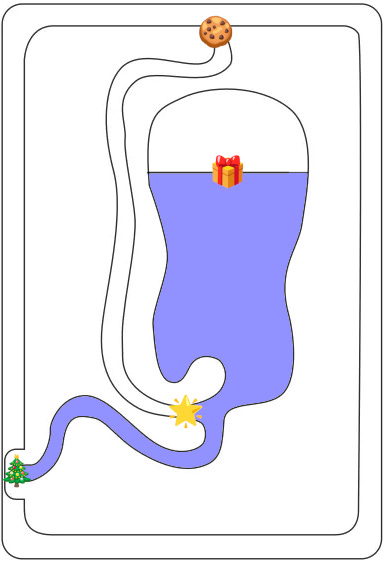As we all know, the turn of the year is when apartment plants die. As everyone, I went on vacations, leaving my little plants – who are already at death’s door as a baseline – unattended. To make things worse, all my roommates went away at the same time, leaving the plants completely home alone.
One way to save my plants would be to have a flask full of water with a very narrow opening, so the water slowly drips into the plant. The problem is that the flow will be very fast at the beginning, then gradually slow down as there is less water left in the bottle.
Fortunately, we live in the Glorious Era of Science and Progress and there is a solution. I think it’s interesting enough to deserve a little explanation.
Passive automata
First, I took a sheet of acrylic plastic and laser-cut the following mysterious shapes:
The part in the middle is a mould where I poured two-parts silicone, after sandwiching it between the two panels and screwing it together. Then, after a night of solidification, I opened it, took out the plastic mould to leave only the silicone part, and screwed the panels back, creating this fluidic device:
Believe it or not, if you fill this weird alien-limb-shaped labyrinth with water, it will flow out at a constant rate, regardless of how much water remains inside. This works in a completely passive way – no need for expensive control systems like pumps, servomotors or roommates.
I didn’t come up with this design: it’s just a heavily-rebranded version of a 17th-century contraption called Mariotte’s bottle. Let’s see how it works with a Christmas-themed diagram:
Water flows out through the needle in 🎄, and air enters through 🍪. In a normal flask, the air input would be at the top, so it can always enter. But here, air comes from 🌟, below the water. So it can only enter if the air pressure at 🌟 is higher than the water pressure at the same point.
What’s the water pressure there? It’s determined by the height of the water between 🎁 and 🌟 (the pressure head), plus the pressure from the air trapped at the top. That pressure is negative compared to the atmosphere – as the weight of water pulls it down, the air above 🎁 expands like a spring.
So here’s what happens: as water exits through 🎄, the air expands and the pressure at 🌟 goes down, until it becomes equal to atmospheric pressure. At that point, a bubble of air enters the main container. This increases the amount of air at the top, allowing the water to go down further, flowing out of 🎄. This brings the pressure in 🌟 back up, creating a negative feedback loop.
In other words, the air at the top constantly adjusts its volume to keep 🌟 exactly at atmospheric pressure! Since atmospheric pressure is constant, the pressure at 🌟 must be constant too. And since the pressure head between 🎄 and 🌟 is also constant, it means that 🎄 is kept at a constant pressure, giving us a constant flow. It’s basically a passive control system. I’m also happy that the silicone-sandwich approach worked. I should experiment with it more in the future (maybe a kefir chemostat?)
As for my plants, as far as I can tell, they are still in their usual between-life-and-death state, so I’ll consider that a success by the standard of my gardening skills.







This is a great article, but I don't understand why the “alien-limb-shaped labyrinth” was necessary. The argument you give for why the pressure at the outlet is constant doesn’t seem to depend on the shape of the bottle. It just requires that the air inlet be below the water level in the bottle. So why did you choose such an oddly specific shape? Is there some secret reason why that shape is optimal?